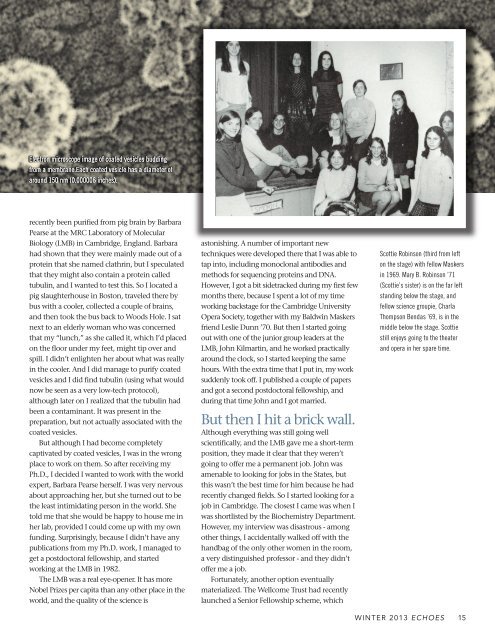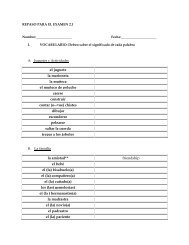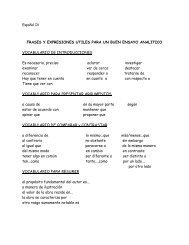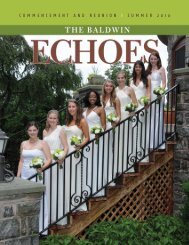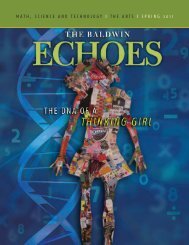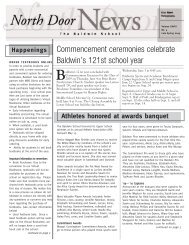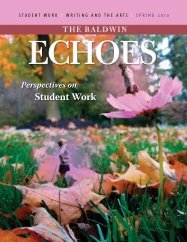Winter 2013 - Baldwin School
Winter 2013 - Baldwin School
Winter 2013 - Baldwin School
You also want an ePaper? Increase the reach of your titles
YUMPU automatically turns print PDFs into web optimized ePapers that Google loves.
Electron microscope image of coated vesicles budding<br />
from a membrane.Each coated vesicle has a diameter of<br />
around 150 nm (0.000006 inches).<br />
recently been purified from pig brain by Barbara<br />
Pearse at the MRC Laboratory of Molecular<br />
Biology (LMB) in Cambridge, England. Barbara<br />
had shown that they were mainly made out of a<br />
protein that she named clathrin, but I speculated<br />
that they might also contain a protein called<br />
tubulin, and I wanted to test this. So I located a<br />
pig slaughterhouse in Boston, traveled there by<br />
bus with a cooler, collected a couple of brains,<br />
and then took the bus back to Woods Hole. I sat<br />
next to an elderly woman who was concerned<br />
that my “lunch,” as she called it, which I’d placed<br />
on the floor under my feet, might tip over and<br />
spill. I didn’t enlighten her about what was really<br />
in the cooler. And I did manage to purify coated<br />
vesicles and I did find tubulin (using what would<br />
now be seen as a very low-tech protocol),<br />
although later on I realized that the tubulin had<br />
been a contaminant. It was present in the<br />
preparation, but not actually associated with the<br />
coated vesicles.<br />
But although I had become completely<br />
captivated by coated vesicles, I was in the wrong<br />
place to work on them. So after receiving my<br />
Ph.D., I decided I wanted to work with the world<br />
expert, Barbara Pearse herself. I was very nervous<br />
about approaching her, but she turned out to be<br />
the least intimidating person in the world. She<br />
told me that she would be happy to house me in<br />
her lab, provided I could come up with my own<br />
funding. Surprisingly, because I didn’t have any<br />
publications from my Ph.D. work, I managed to<br />
get a postdoctoral fellowship, and started<br />
working at the LMB in 1982.<br />
The LMB was a real eye-opener. It has more<br />
Nobel Prizes per capita than any other place in the<br />
world, and the quality of the science is<br />
astonishing. A number of important new<br />
techniques were developed there that I was able to<br />
tap into, including monoclonal antibodies and<br />
methods for sequencing proteins and DNA.<br />
However, I got a bit sidetracked during my first few<br />
months there, because I spent a lot of my time<br />
working backstage for the Cambridge University<br />
Opera Society, together with my <strong>Baldwin</strong> Maskers<br />
friend Leslie Dunn ’70. But then I started going<br />
out with one of the junior group leaders at the<br />
LMB, John Kilmartin, and he worked practically<br />
around the clock, so I started keeping the same<br />
hours. With the extra time that I put in, my work<br />
suddenly took off. I published a couple of papers<br />
and got a second postdoctoral fellowship, and<br />
during that time John and I got married.<br />
But then I hit a brick wall.<br />
Although everything was still going well<br />
scientifically, and the LMB gave me a short-term<br />
position, they made it clear that they weren’t<br />
going to offer me a permanent job. John was<br />
amenable to looking for jobs in the States, but<br />
this wasn’t the best time for him because he had<br />
recently changed fields. So I started looking for a<br />
job in Cambridge. The closest I came was when I<br />
was shortlisted by the Biochemistry Department.<br />
However, my interview was disastrous - among<br />
other things, I accidentally walked off with the<br />
handbag of the only other women in the room,<br />
a very distinguished professor - and they didn’t<br />
offer me a job.<br />
Fortunately, another option eventually<br />
materialized. The Wellcome Trust had recently<br />
launched a Senior Fellowship scheme, which<br />
Scottie Robinson (third from left<br />
on the stage) with fellow Maskers<br />
in 1969. Mary B. Robinson ’71<br />
(Scottie’s sister) is on the far left<br />
standing below the stage, and<br />
fellow science groupie, Charla<br />
Thompson Bendas ’69, is in the<br />
middle below the stage. Scottie<br />
still enjoys going to the theater<br />
and opera in her spare time.<br />
WINTER <strong>2013</strong> ECHOES<br />
15


